Want a more visual way to maintain your timeline?
This chapter is more of a reflection on reference and resource materials, and how they relate to the timeline. Feel free to hop skip and jump to the next chapter.
Keeping the useful alive
Most people, I'm sure you would agree, see reference and resource material as part of their non-actionable data. But surprisingly, at least in my case, the overwhelming majority of my reference and resource material sits squarely on my timeline. I do have reference and resource material that does not live directly on my timeline – but it is very minuscule in comparison to that which does live on my timeline.
This is a worthwhile observation to make and something worth thinking through… because we've got to figure out what genuinely doesn't make it into the timeline, and if not, where it lies in relation to the timeline.
The objective is not to cram anything and everything into the timeline just for the sake of it… But more so, to understand the extent of the timeline, as an overarching system – as well as making our useful information as useful as it can be. The timeline allows our information to be an interactive, living body of knowledge.
Our information helps us to look back and to look forward. It helps us to see where we're coming from and where we're going. We can see our trajectory, and we get to build momentum.
Most of my reference and resource material is kept alive on my timeline… and it's interesting to analyze. There's a reason why I got it all into WorkFlowy in the first place, and I've got to think through how useful it is moving forward.
This is not to say that the timeline is stuffed choc-a-block with as much as possible. It's not brimming to overflowing. My timeline has the essentials… and the things that are there make sense to me to be there.
Let's take a look at some practical examples of what I'm talking about.
My preferred pastime
If I could, I would spend 10 times more time birdwatching than I already do, which is significant. I often wonder to myself why I didn't study Ornithology.
As with the birdwatching outline below, most of my data is built around doing. It lives in an outline (⧉) just below and in line with my timeline (as seen previously):
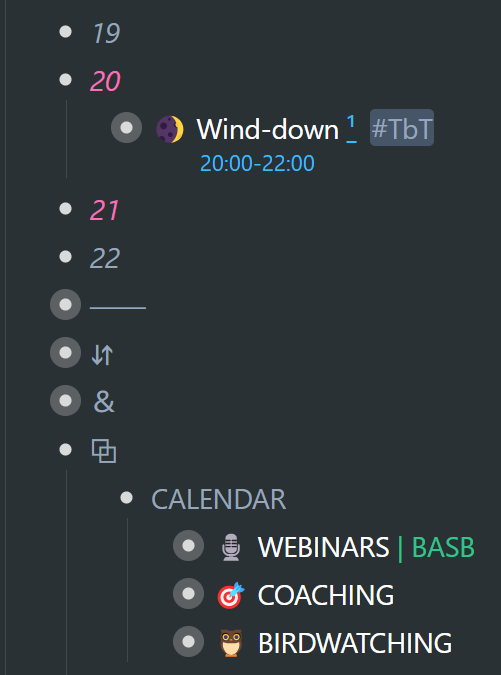
It's also nested in a "CALENDAR" list, indicating that it is well-represented somewhere on my timeline. And within the bird watching outline, I have a section of items that are mirrored into my calendar…
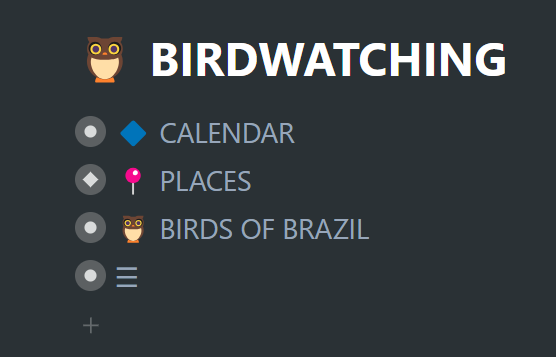
This outline is inextricably linked to scheduled activities on my timeline, because parts of it are mirrored into those activities… like the "PLACES" I'd like to explore outline, which is mirrored into a weekly activity with my elder daughter, Emma – scheduled for every Monday.
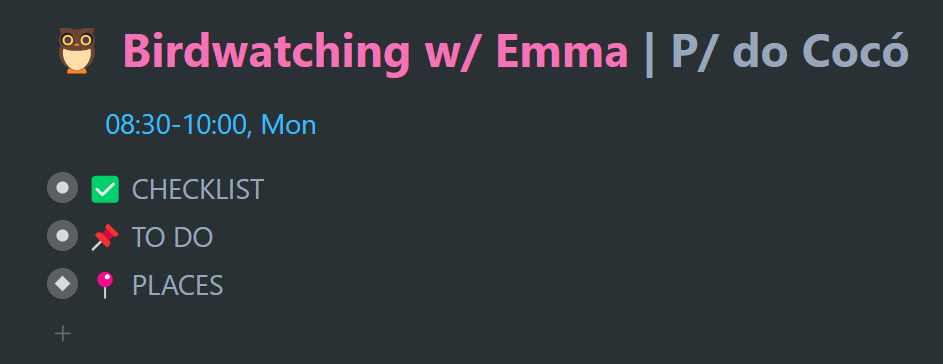
So such activities are always going to point back to the main outline, which I often refer to for the resources it contains. For instance, I have a list of the birds of Brazil—about 2,000 species —grouped by family, each with multiple resource links, and information in both Portuguese and English.
I've also tagged species on my life list so that I can filter for them:
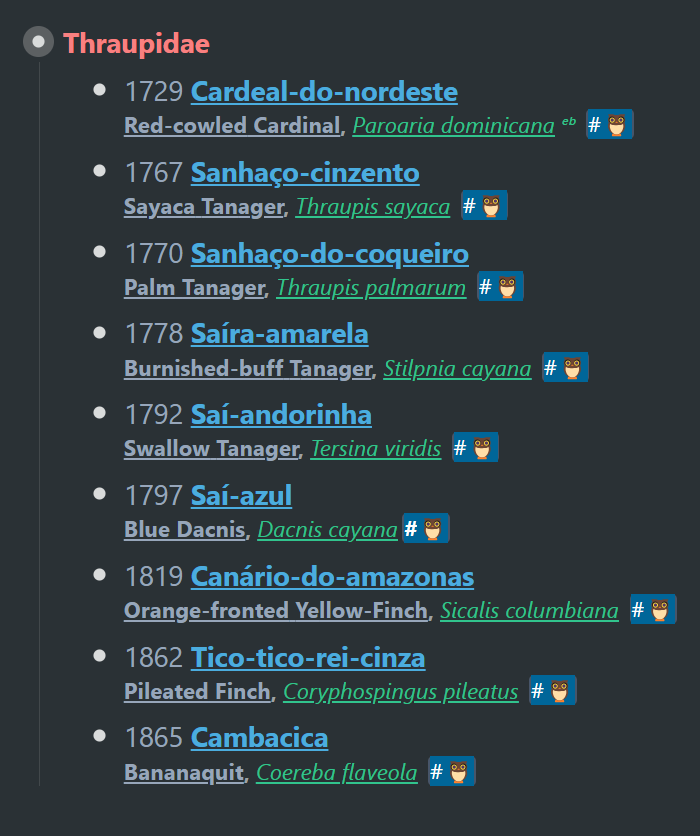
There are beautiful birding apps out there, of which I use several, but this is tailor-made to what I want. It's a personal knowledge base – and it's right there in the mix of things, being used.
If your reference or resource material has a connection to the timeline, it remains relevant – and more accessible than if it were tucked away many layers deep in a forgotten outline. As long as your resource material is connected to—or lives on—your timeline, it remains alive.
Reading
My reading outline is highly mobile. It follows me around in my daily planner:
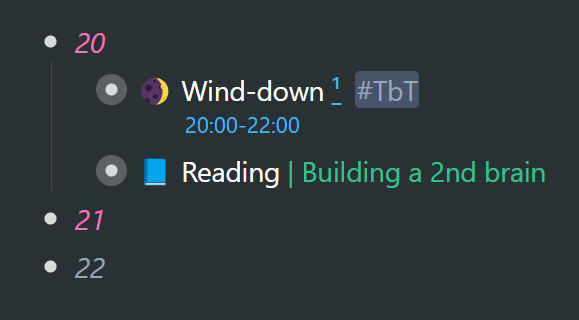
At the moment, I'm halfway through a book by Tiago Forte, "Building a Second Brain" – and so it says so on the outside of the reading outline/ prompt. And this is what I have on the inside:
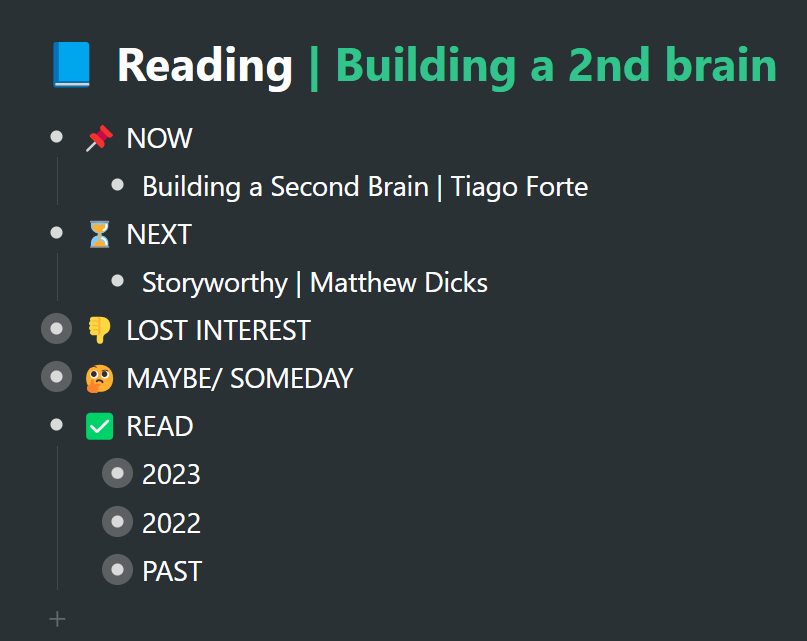
There are always books that I'm wanting to get to next. I like to see where I've come from and where I'm going. I've even got an outline for books that have lost interest in recently—having gotten about halfway through each—and decided to move on to things that interested me more:
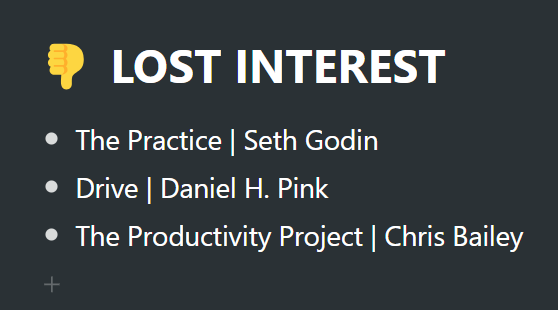
So most of the information in this book-reading outline is resource or reference material… yet it comes along for the ride. And if book summaries are more useful to me elsewhere along my timeline, that's where they'll go. You will have already seen the chapter, "Reinforce, reflect, remember, repeat" », where I squeeze as much usefulness as I can out of book-summary chapters.
Resource material within projects
You will find that a vast amount of your resource and reference material is related to projects. And as you know, projects can either live directly on or be represented on your timeline. This makes that information all the more relevant. Everyone has resource and reference material related to projects embedded in project outlines… but if your project is dead in the water, so is your valuable resource material.
Many have read Tiago Forte's work and are familiar with his PARA system: Projects, Areas, Resource, Archives. There's a strong focus on doing – and a principle Forte keeps coming back to, is that of organizing all of your captured material according to action. This is what the timeline does… it gives a logical, reasonable or opportune time to the actionable items that you've taken the care, and gone to the lengths, to bring into your personal knowledge base – along with all its supporting resource and reference material.
There is relatively little I have in the way of reference and resource material that lives in a dedicated outline at the bottom of my timeline. It's there for if I ever need it. And when I know that I won't need it, it gets exported out of WorkFlowy.
About Minimalism and Focus →Workflowy is a minimalist note taking app that helps you organize your life. Simple enough to hold your grocery list, powerful enough to hold your entire life.